Draw YOUR Story: An Art and Storytelling Program Linking Older Adults and Medical Students
Sujal Manohar; Oluwapelumi Oloyede; and Mary Horton
https://doi.org/10.52713/SYDI8758
Abstract
The COVID-19 pandemic drastically limited activities at senior care facilities, exacerbating the loneliness and social isolation already prevalent in these settings. We describe a creative intervention for addressing these challenges and fostering intergenerational connections between students and older adults.
Draw YOUR Story is an art and storytelling program at St. Dominic Village (SDV) Senior Care Community. Supported by the Albert Schweitzer Fellowship, this program has three major goals: (1) to reduce loneliness among older adults; (2) to foster intergenerational relationships between older adults and student volunteers; (3) to utilize art and storytelling activities as an avenue for building these connections.
Each session has a unique theme and begins with open-ended questions to spark conversation. While sharing stories, participants create a small drawing or painting on a cardstock square. The artwork, which can take an abstract or literal form, is inspired by their story or that of another participant. At the end of the program, we created a collaborative art exhibition that featured drawings from each session.
In evaluating this program, we found that Draw YOUR Story led to a statistically significant increase in medical student comfort with older adults. It also encouraged older adults to learn new skills and reflect on their experiences. We offer Draw YOUR Story as a model for other health professions programs seeking to engage with older adults.
Keywords: older adults, elderly, art, storytelling, intergenerational, medical students
Overview of Draw YOUR Story Program
“I am not an artist!” The woman seemed confident in her lack of creative ability, doubtful that she could contribute to an art program. Multiple participants at the senior care facility echoed this sentiment throughout the first few sessions of our art and storytelling initiative, Draw YOUR Story. While some older adults initially assumed that artistic talent was a prerequisite for participation, they soon realized that all they needed was a story. And everyone has a story.
Draw YOUR Story is an art and storytelling program at the St. Dominic Village (SDV) Senior Care Community aiming to address loneliness and social isolation among older adults. The program is centered around stories related to life experiences, family traditions or culture, and more, that inspire a simple drawing or painting.
It is well known that older adults in senior care facilities face loneliness and social isolation. These issues were exacerbated during the COVID-19 pandemic as many older adults were unable to see family, friends, or even other residents to minimize infection risk (Levere et al. 2021; Bundy et al. 2021). Draw YOUR Story responds to these issues through group programs where residents can share their stories and draw their perspectives. This program also aims to reduce the generational gap between students and older adults by incorporating medical student and undergraduate volunteers into the sessions.
Older Adulthood and Aging
Older adults in residential living communities experience a unique set of circumstances that lead to loneliness and isolation. Isolation is the objective loss of social contacts, and loneliness is the subjective emotional feeling of this loss in relationships. These feelings are perpetuated in the older adult population due to changes such as relocation into assisted living, loss of social networks, widowhood, and retirement from employment. Extensive literature outlines the detrimental effects of isolation in older adults, including increased mortality (Beller and Wagner 2018; National Academies of Sciences, Engineering, and Medicine 2020).
In recent years, our aging population has drawn attention to isolation and loneliness as a public health concern. The US Census Bureau predicts that our population will have more citizens over 65 than under 18 years in the next 12 years, a phenomenon known as the “graying of America” (US Census Bureau 2017). Understanding and catering to the unique needs of this population will become an increasingly important piece of medical care. Institutionalized senior citizens experience a greater level of objective isolation, as defined by a decrease in social contacts. Studies show this reduced network can lead to new feelings of loneliness, increased depressive symptoms, and a decline in cognitive function (National Academies of Sciences, Engineering, and Medicine 2020). Residents of assisted living facilities are at greater risk for cognitive decline compared to their peers remaining in the community (Harmand et al. 2014).
International attention to the effect of loneliness in the wake of COVID-19 further establishes the present relevance of this issue. Shelter-in-place orders locked down assisted living communities and discontinued visits and activities. In many cases, protecting this vulnerable population from the pandemic came at great cost to their social networks. A study in San Francisco investigated the effects of COVID-19 regulations on community-dwelling older adults; over half of the residents reported increased feelings of loneliness, with many indicating increased anxiety and depression (Kotwal et al. 2021). In 2023, the United States surgeon general even issued a statement about the loneliness epidemic as a public health crisis in the larger population (US Department of Health and Human Services 2023).
For our project, we explored these systemic challenges in the context of SDV, a nonprofit, faith-based senior living community operated as a ministry of the Roman Catholic Archdiocese of Galveston-Houston. It is affiliated with the Texas Medical Center and located near downtown Houston. SDV serves approximately 300 residents a year in three levels of care: independent living (IL), assisted living (AL), and skilled nursing at its Rehabilitation and Nursing Center (RNC).
While social isolation is unfortunately common in such living facilities, cognitive stimulation and social engagement have been shown to improve the mental health and wellbeing of aging adults (Macedo et al. 2015). Narrative medicine is an emerging discipline that values the ability to acknowledge, engage, and act on the experiences and plights of others. It is an effective method for connecting human experiences, deepening networks, and strengthening communication (Charon 2001). The exchange of stories requires processing, synthesis, reflection, and recall, and exercises both fluid and crystallized intelligence.
Project Development
The program was supported by the Albert Schweitzer Fellowship (ASF) of Houston-Galveston for the 2022-23 academic year. This fellowship provided the infrastructure to link us, medical students Sujal Manohar and Oluwapelumi Oloyede, with faculty advisor Dr. Mary Horton, and to connect us with the SDV community.
Draw YOUR Story built upon an existing partnership with SDV, which started with medical student Sree Padalugu (ASF fellow 2021-22) and Horton. Padalugu created a program through ASF that brought medical students together with older adults to build relationships and address loneliness. As ASF encourages future fellows to take on existing projects—in the form of a legacy project—we both approached Padalugu about potentially continuing her work. Padalugu connected with us due to our common interests, and after discussing ideas, we decided to work together and continue collaborating with Horton to address social isolation and loneliness at SDV.
Horton had an existing relationship with SDV during Padalugu’s project. From March 2021 through the end of 2021, she began meeting weekly with SDV IL and AL residents, conducting a pilot autobiographical storytelling activity called Tell YOUR Story, where residents would share stories from their life experiences with those participating in the circle. The current project was built from this pilot effort. The Tell YOUR Story exercise applies the known benefits of narrative medicine and cognitive stimulation (Charon 2007; Duplàa and Crettenand Pecorini 2017) to an isolated population deprived of social interactions during COVID-19.
Horton collaborated with University of Texas (UT) Health Sciences Houston geriatrician and clinician educator Dr. Renee Flores. With additional support from the Dr. Susan Nelson Endowment within the Joan and Stanford Alexander Division of Geriatric and Palliative Medicine Division, Catherine Bryant, then a first-year medical student at McGovern Medical School, conducted a 10-week summer research project in summer 2022. Bryant’s project measured Tell YOUR Story’s impact on the mental health and wellbeing of the residents using standard assessment tools for wellbeing, loneliness, depression, and cognition. The activity garnered interest and engagement from the residents, who regularly brought memorabilia to the meetings. In summer 2022, the popularity and perceived success and benefit of the Tell YOUR Story activity with IL and AL residents at SDV initiated the momentum to extend the program in the fall.
The Draw YOUR Story program began in September 2022, as an extension of the Tell YOUR Story sessions. We led the program during the 2022-23 academic year and passed it on to another team of ASF fellows for the 2023-24 academic year. The program is now continuing with a new team of student leaders in 2024-25. The subsequent sections of this chapter describe the program as it was run in 2022-23.
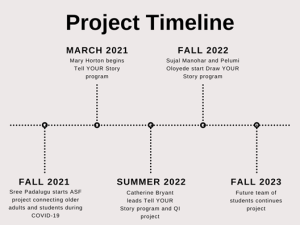
Goals and Structure of Draw YOUR Story
Draw YOUR Story art and storytelling programs offered a focused activity for student volunteers and older residents. Each session consisted of a concurrent storytelling and art-making time; as they shared their stories, participants created a small work of art.
This project had three major goals:
- To address loneliness among older adults (in SDV’s IL, AL, and some RNC communities) who were isolated due to prior COVID-19 restrictions
- To foster intergenerational relationships between older adults and medical student volunteers
- To utilize art and storytelling activities as an avenue for building these connections
A typical session began on Saturday mornings at 10:00 a.m. and lasted until 11:15 a.m., allowing residents time to get to lunch at 11:30 a.m. Students and older adults (from SDV’s AL, IL and RNC communities) sat around a large table with art supplies and a 5” x 5” cardstock square at every seat. All programs had a theme, such as Thanksgiving, pets, or family. We began programs with a “beautiful question” (an open-ended question with no correct answer). These questions served as starting points for discussion, and smaller conversations developed over the course of the session.
Examples of “Beautiful Questions”
What would you like people to know about you?
What is your family like?
What is your favorite thing about fall?
What do you like about animals?
How do you like to celebrate Halloween?
The sessions also encouraged simultaneous art-making and storytelling. That is, while others were sharing their stories, participants began creating their art piece. This led to stories and artworks that complemented each other, as participants shared their creative process with the group and took inspiration from ongoing conversation. The artwork was often loosely related to their story or that of another participant. Often, residents brought in photos or items related to that session’s theme; one participant shared a family photo album, and another brought a handmade quilt. At the end of the session, the group reconvened and all participants shared their drawings and the stories behind them.
Importantly, the program could adapt to the needs of SDV residents and volunteers. For example, questions and conversation topics could be adjusted if some participants had cognitive changes. Also, in response to low attendance at AL sessions, we created a larger session that combined both AL and IL rather than having separate programs. This may be ideal for SDV residents, who reported barriers between the different communities at the facility.
The older adult participants were primarily white, with some Hispanic and African American members, and all shared a common Christian faith. In contrast, the students were a diverse group in their 20s, including individuals from white, African American, Hispanic, and Asian backgrounds and a wide range of spiritual practices. The diversity in both age and cultural background contributed to varying levels of engagement during the sessions.
Volunteer Recruitment
Student volunteers were a key part of the program. Our volunteers, many of whom had interests in health-related careers, came from institutions in the Houston area such as Baylor College of Medicine, University of Houston College of Medicine, University of Houston, and Rice University. Volunteers were recruited through word of mouth, university webpages, flyers, and information sessions. After expressing interest via an online form, students attended a mandatory orientation through SDV and submitted their COVID-19 vaccination cards. Upon completing orientation, volunteers were required to commit to at least three sessions per semester.
The Draw YOUR Story activity encouraged residents within the SDV community to not only expand, but deepen their social networks. Older adults contributed their rich life experiences and wisdom to the group. Many were eager to share and connect with others at SDV as well as with younger students in the area. The students offered a different perspective and an interest in learning from older adults. All participants had their own stories and insights to share, and it was valuable to see how one’s experiences may differ from others’. Medical students also gained the opportunity to connect with older community members. For future physicians, it was helpful to gain comfort with older adults outside of a clinical environment before interacting with them in various healthcare settings. In the 2022-23 academic year, students were also searching for in-person opportunities to serve their communities after COVID-19 had limited such activities for the two years prior.
Final Exhibition
A final component of our project was an end-of-year celebration event in May 2023, where SDV residents and volunteers celebrated their stories and connections with each other. We combined the small square drawings from several Draw YOUR Story sessions to create collaborative mosaic displays. Over 60 attendees, including older adults, family members, student volunteers, and community members, enjoyed the exhibition and refreshments. Older adult participants proudly shared their creations with friends and family members. This event served as a tangible reminder of the value of intergenerational connections for both older adults and student volunteers. It also reinforced the legacy project (started by Padalugu) built at this location and encouraged future fellows to take part in the program while raising awareness of Draw YOUR Story within SDV.
Connections to Similar Programs
Draw YOUR Story utilized the benefits of narrative medicine to engage with the older adult community. Aspects of the art and storytelling activities were modeled after existing strategies like TimeSlips, a method of creative storytelling designed for people with dementia or cognitive impairment. In TimeSlips activities, a photograph is used as a visual stimulus. Participants collaboratively create a story about the photograph and discuss the story together. This program has been proven to be successful in older adults, especially those with dementia (Bahlke et al. 2010; Vigliotti et al. 2018).
Draw YOUR Story also took inspiration from Visual Thinking Strategies (VTS), a structured pedagogical approach to openly discussing works of visual art (Yenawine 2013). When observing a work of art, the facilitator poses three questions crafted to motivate and maintain inquiry: (1) What’s going on in this picture? (2) What do you see that makes you say that? (3) What more can we find? (Yenawine 2013).
For Manohar, one of the students leading Draw YOUR Story, this program felt like a natural extension of her work as a gallery guide with an art program for adults with dementia. The Reflections Program at the Nasher Museum of Art at Duke University offers free art gallery tours for adults with dementia and their care partners; Manohar has been involved for the past four years. Through art observation, group discussion, and art and music activities, older adults find community and a creative outlet at the art museum. Like Reflections, Draw YOUR Story also builds both intergenerational and intragenerational connections (Manohar and Ruhle 2021).
We incorporated elements of these programs when we observed and discussed everyone’s artwork at the end of the session. Our project also expanded upon the previous Tell YOUR Story program by increasing student volunteer recruitment and incorporating arts-based storytelling activities. However, Draw YOUR Story’s approach differed from TimeSlips and VTS because it highlighted storytelling and not necessarily art or visual observation. We also recognize that while the simultaneous art and storytelling session worked well for the SDV residents, this activity may need adaptation for a group with significant memory loss or different needs.
Why Houston?
Houston is home to a large population of medical students and undergraduates who are eager to volunteer and learn from older adults. The city has four medical schools that support ASF fellows, providing a structured program to support student-driven community engagement projects. Rice University and the University of Houston also have undergraduate medical humanities programs. Rice University offers a minor in medical humanities, and the UH Honors College offers a minor in medicine and society. Students in these academic programs are likely to engage in narrative medicine or arts-based activities as extracurriculars.
Institution Number of Draw YOUR Story Volunteers
Baylor College of Medicine 17
University of Houston 4
UH College of Medicine 2
Rice University 2
UT McGovern Medical School 1
Draw YOUR Story sessions consisted of art-making and storytelling time, as the following photos show.
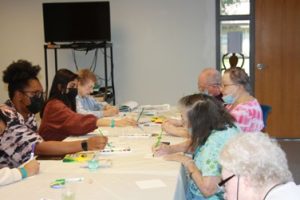
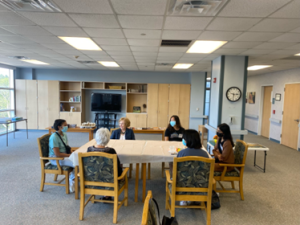
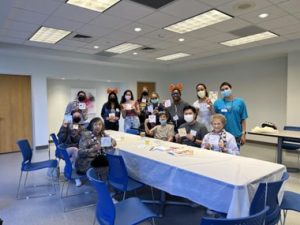
The program culminated in an end-of-year exhibition.
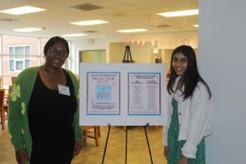
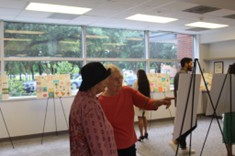
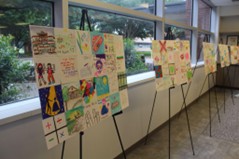
Draw YOUR Story Program Evaluation
As mentioned earlier, Draw YOUR Story was based on similar programs at SDV. To explore whether the new approach to the program was effective, we conducted a program evaluation, described in detail elsewhere (Manohar et al. 2023). Briefly, our research approach used focus groups to understand the effects of this program on SDV residents’ social isolation and loneliness. Three older adults participated in the focus groups, and the transcripts were analyzed independently by three individuals. In addition, we conducted pre- and post-volunteering surveys with student volunteers to see how engaging with older adults via Draw YOUR Story impacted their perceptions of this demographic. The program evaluation was approved by Baylor College of Medicine’s Institutional Review Board.
Our results showed that students had a statistically significant increase in comfort with older adults after volunteering. Older adults reported that the program encouraged them to learn new skills and offered time for reflection (Manohar et al. 2023). Overall, the program fostered valuable intergenerational connections for participants. Focus group results regarding social isolation and loneliness varied; some residents felt more connected to the community, while others continued to feel isolated. This suggested that programs like Draw YOUR Story are only one part of the solution for addressing loneliness in these communities.
The Draw YOUR Story program and its impact were presented at several conferences—including the Health Humanities Consortium, Gold Humanism Summit, and American Academy of Neurology Annual Meeting—to raise awareness about the use of arts programming for older adults.
Evaluation Method Considerations
While our findings suggest several benefits of the program, we acknowledge that participants may have been biased to highlight positive aspects of Draw YOUR Story rather than sharing negative experiences. Our evaluation was limited by the small sample size, and we hope to conduct more rigorous program analyses in future iterations. However, the initial positive results motivate us to continue such programming and research in the future.
Power dynamics based on living arrangements may have affected engagement and responses to the program as well. Participants from IL and AL experienced different levels of social isolation compared to those in the RNC at SDV. For instance, one resident in the RNC emphasized their inability to attend social events, which contrasted with the more social experiences of residents from other living arrangements. Furthermore, the length of stay in these facilities influenced comfort levels, with longer-term residents feeling more at ease sharing their stories, often reflecting on pre-pandemic life. We also noticed that older adults who had higher education often contributed more than others.
Some residents also felt hesitant to participate due to memory loss; they worried about forgetting details in a story or sharing something inaccurately. On more than one occasion, a resident cut their story short and apologized for their memory lapse, despite encouragement from other older adults and student volunteers. Among student volunteers, those who had participated in several sessions often felt more comfortable sharing compared to new volunteers. Despite varied student training levels (medical students of different years, pre-health students), these differences did not appear to impact participation.
From the SDV perspective, Draw YOUR Story has been a success. The SDV leadership team has commended the program’s ability to incorporate students, strengthen connections between residents, and provide a creative outlet. In the future, we aim to utilize other rapid evaluation methods (Smith et al. 2023), which will be particularly useful due to the limited time residents and students are together and the weekly fluctuations in student attendance.
Impact on Future Healthcare Professionals
Programs like Draw YOUR Story can help shape more caring and effective healthcare professionals. During training, medical students focus on medical physiology and knowledge of diagnoses, populations, and medications. The Draw YOUR Story program allows medical students to interact with the person behind the health conditions. Many medical students have limited opportunities for direct patient engagement until the second or third year of their program. Even then, it may be hard to truly understand the older adult population outside of a clinical setting. This program allows health professions students to gain exposure to the perspectives of older adults and their stories, potentially encouraging students to become advocates for members of this demographic.
Improving Older Adult Wellbeing
Due to the social isolation and loneliness that exist in senior care facilities, we believe our work will improve the wellbeing of the residents. Our focus group findings reveal that older adults enjoyed the program due to the opportunity to learn new skills and reflect on their experiences (Manohar et al. 2023).
After Draw YOUR Story began, many residents became regular participants, indicating that they included the activity in their daily schedule. The conversations and stories didn’t stop at one session but often picked up in the following week. We also noticed the friendships that flourished in the sessions, as many residents showed interest in other residents’ lives and stories. The residents provided anecdotal feedback to the volunteers expressing their appreciation for the program.
Contributions to Community Health
We are optimistic that the program will strengthen intergenerational connections within our community, improving mental health and wellbeing for SDV residents and student volunteers alike. This type of art and storytelling program can also be applied to many settings beyond SDV, such as other senior care communities, youth programs, and even hospital environments. We believe our program could be a part of larger solutions to prevent social isolation and loneliness in different populations.
Draw YOUR Story is a tool to address larger issues such as ageism and loneliness in our communities. These creative interactions help combat stereotypes, build social networks, and enhance understanding of older adults.
Conclusion
After the program concluded with the final exhibition in May 2023, we mentored another pair of medical students to continue Draw YOUR Story in the 2023-24 academic year. As a further group of students continues the program in the 2024-25 year, our goal is for Draw YOUR Story to continue as a legacy project through the coming years. We are excited to see how future teams of students will improve the program. While we enjoyed seeing SDV residents and students bond over shared stories, we aim to have Draw YOUR Story become a large-scale intervention in the future, possibly by expanding to other cities with ASF programs.
Initiatives like Draw YOUR Story can be emulated at other institutions or communities, and the underlying narrative medicine techniques can be explored in healthcare, educational, and family settings as well. By writing this chapter as a brief “guideline document,” we hope that others will be inspired to implement similar initiatives. There are also avenues for program expansion, such as including musicians in the program, creating a virtual exhibition of the artwork, and incorporating other approaches like pet therapy.
As we consider the many intersections of the arts and medicine, such storytelling programs have the potential to integrate with medical care and patient wellbeing. For example, it could be valuable to explore how such programs influence the participants’ need for medical interventions. Do Draw YOUR Story residents need lower doses of pain medications after participating in such a program? While such a goal cannot be directly evaluated in our project, it would be powerful to have medical providers “prescribe” participation in creative activities to supplement a patient’s other treatments. This emerging idea, known as arts on prescription, would lead to stronger connections between arts and cultural organizations and care providers (Golden 2023). To be sure, considerable research would be necessary to reach such a goal, but this type of collaboration might have merit.
Draw YOUR Story has shown that being an artist isn’t about creating perfect compositions, but rather about the person doing the art. The program is about drawing your perspective and learning from others’ experiences. Most importantly, the residents at SDV realized during every session that they are creative and have a story worth telling. And for students, we hope that fostering these intergenerational interactions will create not only better future providers but also better human beings.
Acknowledgments
We would like to thank the residents at St. Dominic Village and student volunteers for sharing their stories and participating in the program. We are also grateful for the support and guidance of Carol Jacob and Alonso Martinez.
This project was funded by the Albert Schweitzer Fellowship of Houston-Galveston.
Discussion Questions
- What other types of creative arts could be incorporated into programs like Draw YOUR Story?
- What qualities make a story entertaining?
- Are some stories more valuable than others? Why or why not?
- Why do you think we feel closer to someone after hearing their story?
- What is the role of storytelling in medicine and other health professions?
References
US Department of Health and Human Services. 2023. New surgeon general advisory raises alarm about the devastating impact of the epidemic of loneliness and isolation in the United States [News release]. https://www.hhs.gov/about/news/2023/05/03/new-surgeon-general-advisory-raises-alarm-about-devastating-impact-epidemic-loneliness-isolation-united-states.html
Bahlke, L., Pericolosi, S., and Lehman, M. 2010. Use of TimeSlips to improve communication in persons with moderate–late stage dementia. Journal of Aging, Humanities, and the Arts 4(4): 390-405.
Beller, J., and A. Wagner. 2018. Loneliness, social isolation, their synergistic interaction, and mortality. Health Psychology 37: 808-813. https://doi.org/10.1037/hea0000605
Bundy, H., H. M. Lee, K. N. Sturkey, and A. J. Caprio. 2021. The lived experience of already-lonely older adults during COVID-19. The Gerontologist 61(6): 870-877. https://doi.org/10.1093/geront/gnab078
Charon, R. 2001. Narrative medicine: A model for empathy, reflection, profession, and trust. JAMA 286(15): 1897-1902. https://doi.org/10.1001/jama.286.15.1897
—. 2007. What to do with stories: The sciences of narrative medicine. Canadian Family Physician 53(8): 1265-1267.
Duplàa, E., and B. Crettenand Pecorini. 2017. Narrative gerontology and digital storytelling: What benefits for elders? MOJ Public Health 6. https://doi.org/10.15406/mojph.2017.06.00192
Golden, T.L., A. Bantham, K. Mason, J. Sonke, K. Swaback, M.N. Kuge, A.M. Lokuta, J. Caven, M. Shan, R. Clinesmith, K. Keene, and N. Manhas. 2023. Arts on prescription: A field guide for US communities. Mass Cultural Council and University of Florida Center for Arts in Medicine.
Harmand, M. G.-C., C. Meillon, L. Rullier, J.-A. Avila-Funes, V. Bergua, J.-F. Dartigues, and H. Amieva. 2014. Cognitive decline after entering a nursing home: A 22-year follow-up study of institutionalized and noninstitutionalized elderly people. Journal of the American Medical Directors Association 15(7): 504-508. https://doi.org/10.1016/j.jamda.2014.02.006
Kotwal, A. A., J. Holt-Lunstad, R. L. Newmark, I. Cenzer, A.K. Smith, K.E. Covinsky, D. P. Escueta, J. M. Lee, and C. M. Perissinotto. 2021. Social isolation and loneliness among San Francisco Bay Area older adults during the COVID-19 shelter-in-place orders. Journal of the American Geriatrics Society 69(1): 20-29. https://doi.org/10.1111/jgs.16865
Levere, M., P. Rowan, and A. Wysocki. 2021. The adverse effects of the COVID-19 pandemic on nursing home resident well-being. Journal of the American Medical Directors Association 22(5): 948-954.e2. https://doi.org/10.1016/j.jamda.2021.03.010
Macedo, L. D. E. D. de, T. C. G. D. Oliveira, F. C. Soares, J. Bento-Torres, N. V. O. Bento-Torres, D. C. Anthony, and C. W. Picanço-Diniz. 2015. Beneficial effects of multisensory and cognitive stimulation in institutionalized elderly: 12-months follow-up. Clinical Interventions in Aging 10: 1351-1360. https://doi.org/10.2147/CIA.S80997
Manohar S., P. Oloyede, and M.E. Kollmer Horton. 2023. Evaluating an intergenerational art and storytelling program with older adults and medical students. International Review of Psychiatry. https://doi.org/10.1080/09540261.2023.2278717
Manohar, S., and J. K. Ruhle. 2021. Intergenerational and intragenerational connections within a university art museum program for people with dementia. International Journal of Lifelong Learning in Art Education 4(1). https://scholarscompass.vcu.edu/ijllae/vol4/iss1/11
National Academies of Sciences, Engineering, and Medicine. 2020. Social isolation and loneliness in older adults: Opportunities for the health care system. National Academies Press. https://doi.org/10.17226/25663
Smith, J., J. Ellins, C. Sherlaw-Johnson, C. Vindrola-Padros, J. Appleby, S. Morris, J. Sussex, and N. J. Fulop. 2023. Methods for rapid evaluation. In Rapid evaluation of service innovations in health and social care: Key considerations. National Institute for Health and Care Research. https://www.ncbi.nlm.nih.gov/books/NBK595734/
US Census Bureau. 2017. 2017 national population projections tables: Main series. https://www.census.gov/data/tables/2017/demo/popproj/2017-summary-tables.html
Vigliotti, A. A., Chinchilli, V. M., George, D.R. 2018. Evaluating the benefits of the TimeSlips creative storytelling program for persons with varying degrees of dementia severity. American Journal of Alzheimer’s Disease & Other Dementias 34(3):163-170.
Yenawine, P. 2013. Visual thinking strategies: Using art to deepen learning across school disciplines. Cambridge, Massachusetts: Harvard Education Press.

